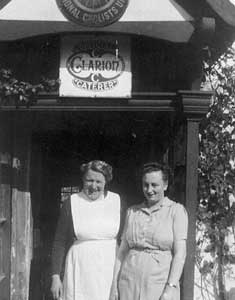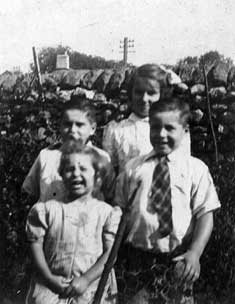- Introduction
- Air Raid Precautions
- Home Guard
- Agriculture
- Education
- Womens Land Army
- Evacuees
- War Service
- Social Events
- End of Hostilities
Clicking on most pictures will show a larger version

Children in the croft behind Malham Village Hall. Winnie Atkinson (evacuee), Jean Simpson (Tennant Farm, Malham), Annetta Hoare (evacuee), Rita Simpson, Barbara Hoare (evacuee)

David Whitehead, an evacuee who stayed in Otterburn.

Children playing at May Queen. Back, evacuees, centre Pat Atkinson,
her cousin Winnie on her left and Barbara Hoare. Front, local girls Jean
Simpson (Tennant House) and Christine Tyson (Malham Cafe)

Malham evacuees : Nick and Annetta Hoare, Pauline Harris, Barbara and
Noel Hoare. Read Barbara's
wartime memories.

Mrs Barratt (left) and Annie Alderson outside South View cafe,
Malham where the Hoare family lived as evacuees.
Malhamdale at War
Evacuees
Evacuees to the district came mainly from Liverpool and the West Riding
towns of Leeds and Bradford. They were organised by the WVS, Mrs Fell
from Otterburn being the local Billeting Officer for the area.
Some children were billeted alone without their mothers, which must have been a pretty terrifying experience, but others came as families, such as the Hoare family from Liverpool, who lived with Mr and Mrs Barratt at Southview Cafe, Malham (now the Post Office), along with Pauline Harris, a friend of Barbara Hoare. (Read Barbara Hoare's wartime memories of Malham)

The Hoare children evacuated from Liverpool to Malham.
Back- Nick and Barbara, front Annetta and Noel .
Some found it difficult to settle and only stayed a short time, deciding
to take their chances with the bombing raids rather than be separated
from the life they knew. But for the ones who did stay any length of time,
it proved to be a fascinating new way of life.
The children of school age mainly attended Kirkby Malham or Airton schools
and generally integrated well. However, Dorothy Ingham remembers a group
turning up from Settle Station to Malham Moor School just for a few days
before being moved on to the Settle area.
Two stayed at Miss Hillary’s Cottage, two with Mrs Lister and two
with Mrs Wood, next to the Gamekeeper’s Cottage, all on the Malham
Tarn Estate.
Recently, a man from near Worthing made enquiries in Settle trying to
trace where he had been billeted as an evacuee. He remembered a ‘lake’
and being taught by a lady who came to school on a pony. With some detective
work, he was put in touch with Edith Carr who worked out the ‘lake’
must have been Malham Tarn, and the teacher Doris Carr who did indeed
travel to Malham Moor School by pony.
Perhaps he was one of the children Dorothy remembers, as within a few
days he had been moved to the Settle area.
Some families did not arrive in the Dale until they had lost their homes
through bombing. Two such families, the Kelbricks and the Baillies from
Liverpool, took up residence in Airton Meeting House which had been converted
by Friends War Relief for the purpose, with Arnold and Phyllis Waterfall
as Wardens.

Click to read the full Society of Friends appeal.
The Meeting House had been partitioned to give a downstairs bedroom and
a bedroom in the gallery, with the Women’s Meeting room as a sitting
room and the stable converted to a kitchen cum dining room, plus two lavatories.
Phyllis did all the cooking although Arnold recalled that the evacuees
did not like the idea of eating a crop of mushrooms which he had found
growing on the muck heap at Kirksyke where he worked for Roger Wright.
Consequently the young nettles served up by Phyllis in spring were presented
as spinach not nettles!
The children came to love the countryside despite the strangeness of it
when they first arrived. One had asked Arnold when he first saw cow claps
in a field, ‘Haven’t they got a lavatory?’ Barbara Purcell
(Hoare) remembers having wonderful times playing in a hay barn and helping
with haytime, but being very wary of cows which were so BIG. She also
has happy memories of sledging on a sledge made for the children by the
blacksmith in Malham.
There were obviously problems for the evacuees. Some of the accommodation
was very cramped, such as the rooms the Hoare family occupied at South
View. They had one room downstairs and a bedroom for Mrs Hoare and the
five children. Barbara also recalls that their father missed them, so
much so that they returned to Liverpool in about 1943 despite the fact
that there were still bombing raids on the city.
But all in all, despite these problems, most evacuees seemed to have enjoyed
their period of time in the Dale and some such as Barbara Purcell, her
sister and one of her brothers, and the gentleman from Worthing have returned
on ‘nostalgia trips’.